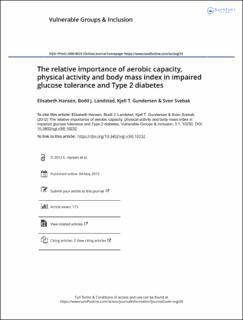| dc.contributor.author | Hansen, Elisabeth | |
| dc.contributor.author | Landstad, Bodil Johanne | |
| dc.contributor.author | Gundersen, Kjell Terje | |
| dc.contributor.author | Svebak, Sven | |
| dc.date.accessioned | 2020-06-23T11:23:05Z | |
| dc.date.available | 2020-06-23T11:23:05Z | |
| dc.date.created | 2012-10-12T13:12:44Z | |
| dc.date.issued | 2012 | |
| dc.identifier.citation | Hansen, E., Landstad, B. J., Gundersen, K. T. & Svebak, S. (2012). The relative importance of aerobic capacity, physical activity and body mass index in impaired glucose tolerance and Type 2 diabetes. Vulnerable Groups & Inclusion, 3(1):10232. doi: | en_US |
| dc.identifier.issn | 2000-8023 | |
| dc.identifier.uri | https://hdl.handle.net/11250/2659156 | |
| dc.description.abstract | Aim: To investigate the relative importance of aerobic capacity, physical activity and body mass index (BMI) for discriminating between people with Impaired Glucose Tolerance (IGT) or Type 2 diabetes and healthy controls. Method: Variables included scores on estimated VO2-max (ml/kg/min) by walking the UKK walking-test, responses to questions on self-reported physical activity and BMI. Design: Participants were recruited into groups of IGT, Type 2 diabetes and healthy controls (N64). Statistical analyses were performed by multifactor ANOVA, bivariate correlations and logistic regression. Result: Obesity, as indicated by BMI, was most evident in the IGT and Type 2 diabetes groups when jointly compared with the healthy controls (p=0.004, OR ≥16.00). However, when separately compared with the healthy controls, BMI scores strongly discriminated between the IGT versus healthy controls but failed to distinguish between Type 2 diabetes and healthy controls. Scores for aerobic capacity and level of physical activity failed to distinguish between healthy controls and IGT as well as Type 2 diabetes status. Conclusion: BMI was significantly associated with IGT whereas aerobic capacity and level of physical activity were not predictive of group status for IGT and Type 2 diabetes. The results indicated that primary health care should focus on all means for weight reduction, including physical activity and other life style changes, in order to prevent individuals from escalating into IGT in order to prevent risk of Type 2 diabetes. | en_US |
| dc.language.iso | eng | en_US |
| dc.publisher | Co-Action Publishing | en_US |
| dc.rights | Navngivelse-Ikkekommersiell 4.0 Internasjonal | * |
| dc.rights.uri | http://creativecommons.org/licenses/by-nc/4.0/deed.no | * |
| dc.subject | BMI | en_US |
| dc.subject | Body mass index | en_US |
| dc.subject | Fysisk aktivitet | en_US |
| dc.subject | Physical activity | en_US |
| dc.subject | Diabetes 2 | en_US |
| dc.subject | Fysisk form / kondisjon | en_US |
| dc.subject | Physical Fitness | en_US |
| dc.title | The relative importance of aerobic capacity, physical activity and body mass index in impaired glucose tolerance and Type 2 diabetes | en_US |
| dc.type | Journal article | en_US |
| dc.description.version | publishedVersion | en_US |
| dc.rights.holder | © 2012 The Author(s) | en_US |
| dc.subject.nsi | VDP::Medisinske fag: 700 | en_US |
| dc.subject.nsi | VDP::Medisinske Fag: 700::Klinisk medisinske fag: 750::Endokrinologi: 774 | en_US |
| dc.subject.nsi | VDP::Medisinske Fag: 700::Helsefag: 800::Forebyggende medisin: 804 | en_US |
| dc.source.pagenumber | 13 | en_US |
| dc.source.volume | 3 | en_US |
| dc.source.journal | Vulnerable Groups & Inclusion | en_US |
| dc.source.issue | 1 | en_US |
| dc.identifier.doi | 10.3402/vgi.v3i0.10232 | |
| dc.identifier.cristin | 950314 | |
| cristin.unitcode | 204,80,0,0 | |
| cristin.unitname | Fakultet for lærerutdanning og kunst- og kulturfag | |
| cristin.ispublished | true | |
| cristin.fulltext | original | |
| cristin.qualitycode | 0 | |

